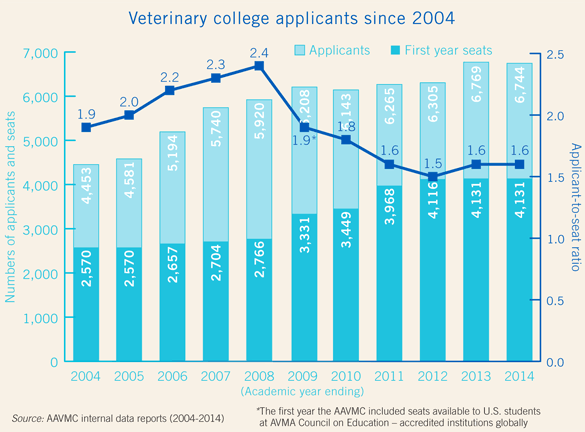College enrollment up, applicant-to-seat ratio down
The veterinary applicant-to-seat ratio has decreased more than previously thought, while first-year enrollment has seen a noticeable bump in the past two years, but tuition growth may be slowing. All that’s according to the 2014-2015 Association of American Veterinary Medical Colleges annual data report, released earlier this year.
The mean tuition at U.S. veterinary colleges continues to increase but at a slower pace in more recent years. Resident tuition grew 21.3 percent from 2006-2010, compared with 12.3 percent from 2010-2015; the mean for 2015 was $22,448. Nonresident tuition, which includes private universities’ rates, increased 10.3 percent from 2006-2010 compared with 5.6 percent from 2010-2015; the mean for 2015 was $46,352.
Meanwhile, total enrollment at U.S. veterinary schools has increased 2.1 percent annually over the past 10 years, from 9,758 in 2005 to 12,395 in 2015. That’s a higher pace than the 0.4 percent annual growth rate from 1985-2005.
In the AAVMC’s advocacy survey for 2010, the association asked U.S. veterinary colleges whether they planned to increase seats between 2010 and 2015. Back then, it appeared the aggregate first-year class size would grow between 5.7 and 8 percent through 2015. In reality, there was a 26 percent increase in first-year class size from 2010-2015. The biggest jumps came in just the past two years, from a total of 2,981 first-year students at U.S. veterinary colleges in 2013 to 3,310 in 2014 to 3,586 in 2015. That’s on top of the total growth rate of first-year seats at U.S. veterinary colleges from 2005-2010, which was 10.3 percent.
At the same time, it appears as though growth in the number of applicants to veterinary colleges has not kept pace with the growth in number of first-year seats. Applicants through AAVMC’s Veterinary Medical College Application Service increased by about 52 percent—from 4,440 to 6,769—from 2002-2013.
Furthermore, approximately 79 percent of VMCAS users, who represent more than 90 percent of U.S. applicants, apply to more than one veterinary college. The mean is four applications per applicant. Therefore, the national applicant-to-seat ratio is the number to focus on.
In 2008, the applicant-to-seat ratio was 2.4 applicants for each available seat. However, ratios reported up to that year focused on the U.S. colleges and the general pool of applicants, according to Lisa Greenhill, AAVMC director of institutional research and diversity, who has a doctorate in education.
In 2008, however, the association revised the information it gathered to reflect applicants to and seats available to U.S. students at international AAVMC member institutions. Not surprisingly, the ratio dipped the following year, hitting an all-time low of 1.5:1 in 2012.
The AAVMC noted in its report that the quality of the veterinary applicant pool remains very strong. In 2003, the minimum undergraduate GPA for applicants who were admitted was 2.8; today it is 3.3, according to internal AAVMC data. Further, only 12 percent of those in the applicant pool have less than a 3.0 GPA.
“The reality is that there continues to be a steady stream of applicants who are still going to apply to veterinary medicine; they have dreamed of the profession since childhood. I think that our applicant attrition likely reflects a decreased ability to recruit and retain young people with broader interests in (science, technology, engineering, and mathematics) careers who actively choose veterinary medicine after the age of 10. This group will likely need more convincing to consider the profession in the coming years,” Dr. Greenhill told JAVMA.
Should the applicant-to-seat ratio fall below 1:1, this could threaten the long-term viability of some veterinary colleges. A few that have been near the bottom of applications received through VMCAS in recent years were St. George’s University in Grenada, West Indies, which had only 408 applicants for 125 open positions in 2011; Oklahoma State University, which had just 364 applicants for 82 spots in 2012; and Texas A&M University, which had 416 applicants for 132 seats in 2011.
For more information, including the total number of graduates from AAVMC member institutions and enrollment demographics broken down by sex, ethnicity, and home state, visit this site.
Related JAVMA content:
Letting the numbers tell the story (May 1, 2013)
Will veterinary education hit a tipping point? (Feb. 1, 2011)


